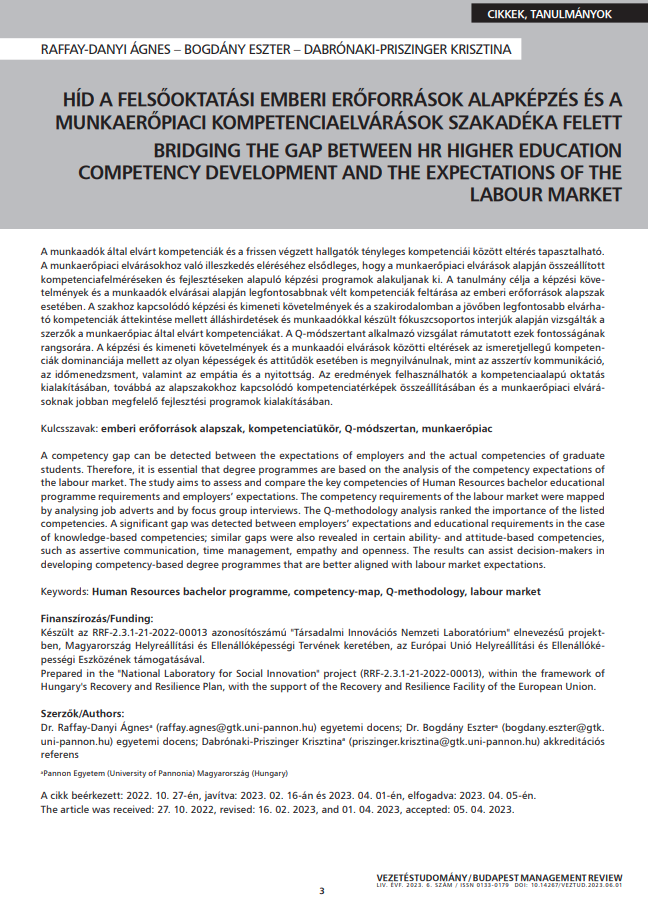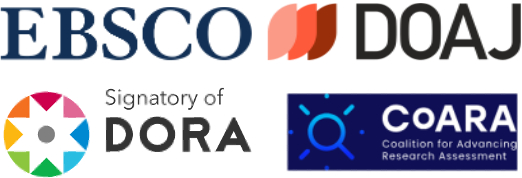Híd a felsőoktatási emberi erőforrások alapképzés és a munkaerőpiaci kompetenciaelvárások szakadéka felett
DOI:
https://doi.org/10.14267/VEZTUD.2023.06.01Kulcsszavak:
emberi erőforrások alapszak, kompetenciatükör, Q-módszertan, munkaerőpiacAbsztrakt
A munkaadók által elvárt kompetenciák és a frissen végzett hallgatók tényleges kompetenciái között eltérés tapasztalható. A munkaerőpiaci elvárásokhoz való illeszkedés eléréséhez elsődleges, hogy a munkaerőpiaci elvárások alapján összeállított kompetencia felméréseken és fejlesztéseken alapuló képzési programok alakuljanak ki. A tanulmány célja a képzési követelmények és a munkaadók elvárásai alapján legfontosabbnak vélt kompetenciák feltárása az emberi erőforrások alapszak esetében. A szakhoz kapcsolódó képzési és kimeneti követelmények és a szakirodalomban a jövőben legfontosabb elvárható kompetenciák áttekintése mellett álláshirdetések és munkaadókkal készült fókuszcsoportos interjúk alapján vizsgálták a szerzők a munkaerőpiac által elvárt kompetenciákat. A Q-módszertant alkalmazó vizsgálat rámutatott ezek fontosságának rangsorára. A képzési és kimeneti követelmények és a munkaadói elvárások közötti eltérések az ismeretjellegű kompetenciák dominanciája mellett az olyan képességek és attitűdök esetében is megnyilvánulnak, mint az asszertív kommunikáció, az időmenedzsment, valamint az empátia és a nyitottság. Az eredmények felhasználhatók a kompetenciaalapú oktatás kialakításában, továbbá az alapszakokhoz kapcsolódó kompetencia térképek összeállításában és a munkaerőpiaci elvárásoknak jobban megfelelő fejlesztési programok kialakításában.
Letöltések
Hivatkozások
Aldamen, H., Alkhateebb, H., Kercher, K., Duncan, K., & Hollindale, J. (2021). Core competencies for the global workplace: A cross-cultural and skill-based simulation project in accounting. Accounting Education, 30(4), 385–412. https://doi.org/10.1080/09639284.2021.1906719
Alden Rivers, B., Armellini, A., Maxwell, R., Allen, S., & Durkin, C. (2015). Social innovation educatation: Towards a framework for learning design. Higher Education, Skills and Work-based Learning, 5(4), 383-400. https://doi.org/10.1108/HESWBL-04-2015-0026
Alsafadi, L., & Abunafesa, R. (2012). ICT skills gap analysis of the Saudi market. Lecture Notes in Engineering and Computer Science, 1, 284–289. https://cdn-prod-pdfsimpli-wpcontent.azureedge.net/pdfseoforms/pdf-20180219t134432z-001/pdf/information-technology-security-gap-analysis-template.pdf
Association for Talent Development. (2015). Bridging the skills gap: workforce development is everyone’s business. http://files.astd.org.s3.amazonaws.com/Communications-Awards/ATD%20Bridging%20the%20Skills%20Gap-2015.pdf
Bencsik, A., & Marosi, I. (2009). A „Tudás Templomai” hívők és szerzetesek nélkül? Avagy tudásmenedzsment a felsőoktatásban. Vezetéstudomány, 40(4), 43- 53. https://dx.doi.org/10.14267/veztud.2009.04.04
Benneworth, P., & Cunha, J. (2015). Universities’ contributions to social innovation: reflections in theory & practice. European Journal of Innovation Management, 18(4), 508-527. https://doi.org/10.1108/EJIM-10-2013-0099
Bogdány, E., Cserháti, G., & Dabronaki-Priszinger, K. (2021). Analysis of gap between competencies developed by higher education and required by employers in Hungary. GiLE Journal of Skills Development, 1, 51-62. https://www.doi.org/10.56611/conf.proc.2021.1.51-6
Carretero, S., Vuorikari, R., & Punie, Y. (2017). Dig- Comp 2.1: The Digital Competence Framework for Citizens with eight proficiency levels and examples of use. Luxembourg: Publications Office of the European Union. https://doi.org/10.2760/38842
Chaminade, C., & Göransson, B. (2020). Unpacking the role of universities in the emergence, development and impact of social innovations – A systematic review of the literature. Technological Forecasting and Social Change, 155(April), 120030. https://doi.org/10.1016/j.techfore.2020.120030
Christo-Baker, E. A. (2012). A portrait of HR: The personality traits of human resources professionals. Journal of the North American Management Society, 6(1), 5. https://thekeep.eiu.edu/cgi/viewcontent.cgi?article=1051&context=jnams
Cohen, D. J. (2015). HR past, present and future: A call for consistent practices and a focus on competencies. Human Resource Management Review, 25(2), 205-215. https://doi.org/10.1016/j.hrmr.2015.01.006
Cross, R. M. (2005). Exploring attitudes: The case for Q methodology. Health Education Research, 20(2), 206-213. https://doi.org/10.1093/her/cyg121
Dajnoki, K., & Héder, M. (2017). Új szelek fújnak – a HR válasza a globalizáció és a változás kihívásaira. Hadtudomány, 27(E), 84-93. https://doi.org/10.17047/HADTUD.2017.27.E.84
Fajaryati, N., Budiyono, B., Akhyar, M., & Wiranto (2020). The employability skills needed to face the demands of work in the future: systematic literature reviews. Open Engineering, 10(1), 595-603. https://doi.org/10.1515/eng-2020-0072
Frankenfeld, C.L. (2017). Trends in employer postings for epidemiology jobs: an analysis of PublicHealth- Jobs.net data from 2003 to 2016. Annals of Epidemiology, 27(9), 553-557. https://doi.org/10.1016/j.annepidem.2017.08.007
Guvenen, F., Kuruscu, B., Tanaka, S., & Wiczer, D. (2020). Multidimensional skill mismatch. American Economic Journal: Macroeconomics, 12(1), 210-244. https://doi.org/10.1257/mac.20160241.210
Handel, M. (2012). Trends in job skill demands in OECD countries. OECD Social, Employment and Migration Working Papers, 143. Paris: OECD Publishing. https://doi.org/10.1787/5k8zk8pcq6td-en
Harman, G., Hayden, M., & Pham, T.N., (2010). Higher education in Vietnam: reform, challenges and priorities. Dordrecht, The Netherlands: Springer. Hensel, D., Toronto, C., Lawless, J., & Burgess, J. (2022). A scoping review of q-methodology nursing education studies. Nurse Education Today, 109, 105220. https://doi.org/10.1016/j.nedt.2021.105220
Herbert, I. P., Rothwell, A.T., Glover, J. L., & Lambert, S. A. (2020). Graduate employability, employment prospects and work-readiness in the changing field of professional work. The International Journal of Management Education, 18(2), 100378. https://doi.org/10.1016/j.ijme.2020.100378
Hercz M., Koltói L., & Pap-Szigeti R. (2013). Hallgatói kompetenciaértékelés és modellkutatás. Felsőoktatási Műhely, 7(1), 83–97. http://hdl.handle.net/10831/83010
Hirudayaraj, M., & Baker, R. (2018). HRD competencies: analysis of employer expectations from online job postings. European Journal of Training and Development, 42(9), 577-596. https://doi.org/10.1108/EJTD-04-2018-0036
Ho, G.W.K. (2017). Examining perceptions and attitudes: a review of likert-type scales versus q-methodology. Western Journal of Nursing Research, 39(5), 674-689. https://doi.org/10.1177/0193945916661302
Hofmeister-Tóth, Á. & Simon, J. (2006). A Q-módszer elmélete és alkalmazása a marketingkutatásban. Vezetéstudomány, 37(9), 16-26. https://doi.org/10.1177/0193945916661302
Jackson, D. (2016). Re-conceptualising graduate employability: the importance of pre-professional identity. Higher Education Resesarch Development, 35(5), 925–939. https://doi.org/10.1080/07294360.2016.1139551
International Labour Office. (2019). Skills and jobs mismatches in low- and middle-income countries. Geneva: International Labour Office. https://www.ilo.org/wcmsp5/groups/public/---ed_emp/documents/publication/wcms_726816.pdf
Kis K., Hampel Gy., & Benkő-Kiss Á. (2019). Végzett hallgatók elvárt munkaerőpiaci kompetenciáinak vizsgálata. Jelenkori Társadalmi és Gazdasági Folyamatok, 14(1), 223–232. https://doi.org/10.14232/jtgf.2019.1.223-232
Lanier, C.R. (2009). Analysis of the skills called for by technical communication employers in recruitment postings. Technical Communication, 56(1), 51-61. https://www.ingentaconnect.com/contentone/stc/tc/2009/00000056/00000001/art00008
Mclean, D. D., Hurd, A. R., & Jensen, R. R. (2005). Using Q-methodology in competency development for CEOs in public parks and recreation. Managing Leisure, 10(3), 156-165. https://doi.org/10.1080/13606710500239012
Meyer, M. (2017). Qualifications and competencies for population health management positions: a content analysis of job postings. Population Health Management, 20(6), 475–485. https://doi.org/10.1089/pop.2016.0197
Munkácsi, A. (2021). Competencies required for the implementation of and efficient supply chain from the perspectives of students and the labour market. Vezetéstudomány, 52(5), 52-67. https://doi.org/10.14267/VEZTUD.2021.05.05
Noe, R., Hollenbeck, J., Gerhart, B., & Wright, P. (2010). Human resource management: gaining a competitive advantage. New York, NY: McGraw Hill.
Obermayer, N., Csizmadia, T., & Hargitai, D. (2022). Influence of Industry 4.0 technologies on corporate operation and performance management from human aspects. Meditari Accountancy Research, 30(4), 1027-1049. https://doi.org/10.1108/MEDAR-02-2021-1214
Paige, J. B., & Morin, K. H. (2016). Q-sample construction: a critical step for a q-methodological study. Western Journal of Nursing Research, 38(1), 96–110. https://doi.org/10.1177/0193945914545177
Pirohov-Tóth, B. & Kiss, Zs. (2022). A Covid-19 vírus munkavállalói kompetenciákra gyakorolt hatása. Új Munkaügyi Szemle, 3(2), 13-24. https://www.metropolitan.hu/upload/bbae66217ef4920cf-6754f1ee9fecb72b20b2dab.pdf
Pol, E., &Ville, S. (2009). Social innovation: buzz word or enduring term? Journal of Socio-Economics, 38(6), 878-885. https://doi.org/10.1016/j.socec.2009.02.011
Poór J., Farkas F., Dombai K., & Karoliny M. (2012). Átalakuló emberierőforrás-menedzsment a multinacionális vállalatok magyarországi leányvállalatainál 2008-2009. Vezetéstudomány, 43(2), 18-28. https://doi.org/10.14267/veztud.2012.02.02
Schwartz K. (2006). Szolgáltató egyetem a tanuló társadalomban – termékfejlesztés felsőfokon. Vezetéstudomány, 37(5), 20-25. https://doi.org/10.14267/VEZTUD.2006.05.03
Rocha, H., Ferreira, A. M., & de Azevedo, F. (2018). Benchmarking higher education in design for social innovation and sustainability: state of art and future challenges. Proceedings of the 5th Design Doctoral Conference, DDC’18: Transgression. IADE - Universidade Europeia, 20 to 22 June 2018. https://www.researchgate.net/publication/333704319_Benchmarking_Higher_Education_in_Design_for_Social_Innovation_and_Sustainability_State_of_Art_and_future_challenges
Rodl, J. E., Cruz, R. A., & Knollman, G. A. (2020). Applying q-methodology to teacher evaluation research. Studies in Educational Evaluation, 65(January), 100844. https://doi.org/10.1016/j.stueduc.2020.100844
Solis-Navarrete, J. A., Bucio-Mendoza, S., & Paneque- Gálvez, J. (2021). What is not social innovation. Technological Forecasting and Social Change, 173, 121190. https://doi.org/10.1016/j.techfore.2021.121190
Srikanth, P. B. (2020). The relative contribution of personality, cognitive ability and the density of work experience in predicting human resource competencies. Personnel Review, 49(8), 1573-1590. https://doi.org/10.1108/PR-09-2018-0329
Szabó I. (2013). A felsőoktatási képzések munkaerő-piaci szempontból. Vezetéstudomány, 44(11), 52-61. https://doi.org/10.14267/VEZTUD.2013.11.05
Szabó K., Juhász T., & Kenderfi, M. (2021). Felsőoktatás a COVID-19 árnyékában – hazai tapasztalatok oktatói oldalról. Vezetéstudomány, 53(6), 2-12. https://doi.org/10.14267/VEZTUD.2022.06.01
Szilágyi R., Fodor K., Lengyel L., Molnár L., & Tóthné Kiss A. (2020). Munkaerő-piaci kompetencia prognózis. In Társadalmi és gazdasági folyamatok elemzésének kérdései a XXI. században (pp. 61-79). Szeged: Szegedi Egyetem. http://doi.org/10.14232/tgfek21sz.5
Taguma, M., & Rychen, D. S. (2016). Education 2030: Key competencies for the future. (Working paper). Paris: OECD. https://www.oecd.org/education/2030/E2030-CONCEPTUAL-FRAMEWORK-KEY-COMPETENCIES-FOR-2030.pdf
Teichler, U. (2009). Higher education and the World of work: conceptual frameworks, comparative perspectives. Leiden: Brill. https://doi.org/10.1163/9789087907563
Tjörnbo, O., & McGowan, K. (2022). A complex-systems perspective on the role of universities in social innovation. Technological Forecasting and Social Change, 174, 120247. https://doi.org/10.1016/j.techfore.2020.120247
Tornwall, J., & McDaniel, J. (2022). Key strategies in scholarly writing instruction for doctor of nursing practice students: a q-methodology study. Nurse Education Today, 108, 105192. https://doi.org/10.1016/j.nedt.2021.105192
Tóthné Téglás, T. & Hlédik, E. (2017). Tehetséghiány vagy kompetenciahiány? In Vállalkozásfejlesztés a XXI. században ( pp. 6 67–684). B udapest: Ó budai Egyetem.
Tóthné Téglás, T., & Kelemen-Erdős, A. (2020). Pályakezdőkkel szembeni kompetenciaelvárások és mérésük. Marketing & Menedzsment, 54(1), 43-54. https://doi.org/10.15170/MM.2020.54.01.04
Tran, L. H. N. (2018). Game of blames: Higher education stakeholders’ perceptions of causes of Vietnamese graduates’ skills gap. International Journal of Educational Development, 62(July), 302-312. https://doi.org/10.1016/j.ijedudev.2018.07.005
Van Den Berg, M. J., Stander, M. W., & Van Der Vaart, L. (2020). An exploration of key human resource practitioner competencies in a digitally transformed agement, 18(4), 1-13. https://doi.org/10.4102/sajhrm.v18i0.1404
Van Der Velden, R., & García-Aracil, A. (2010). Fiatal európai diplomások kompetenciái: A munkapiaci illeszkedés hiánya és ennek megoldása. In Garai, O., Horváth, T. Kiss, L. Szép, L., & Veroszta, Zs. (Eds.), Diplomás Pályakövetés IV. Frissdiplomások 2010 (pp. 51-74). Budapest: Educatio Társadalmi Szolgáltató Nonprofit Kft.
Watts, S., & Stenner, P. (2012). Doing Q Methodological Research: Theory, Method & Interpretation. London: SAGE Publications. World Economic Forum. (2020). World Economic Forum Future of Jobs Report 2020. https://www3.weforum.org/docs/WEF_Future_of_Jobs_2020.pdf
Yang, Y., & Bliss, L. B. (2014). A Q factor analysis of college undergraduate students’ study behaviors. Educational Research and Evaluation, 20(6), 433– 453. https://dx.doi.org/10.1080/13803611.2014.971817
York, K. (2010). Applied Human Resource Management. Thousand Oaks, CA: Sage.
Yorke, M., & Knight, P. (2003). Employability in higher education: what it is – what it is not. York: T he Higher Education Academy. https://www.qualityresearchinternational.com/esecttools/esectpubs/yorkeknightembedding.pdf
Zabala, A., Sandbrook, C., & Mukherjee, N. (2018). When and how to use Q methodology to understand perspectives in conservation research. Conservation Biology, 32(5), 1185-1194. https://doi.org/10.1111/cobi.13123

Downloads
Megjelent
Hogyan kell idézni
Folyóirat szám
Rovat
License
Copyright (c) 2023 Vezetéstudomány / Budapest Management Review

This work is licensed under a Creative Commons Attribution 4.0 International License.
Authors assign copyright to Vezetéstudomány / Budapest Management Review. Authors are responsible for permission to reproduce copyright material from other sources.

